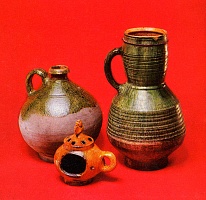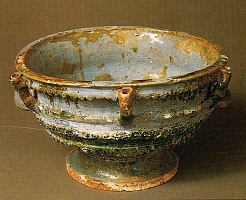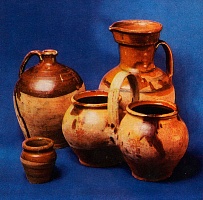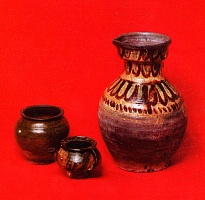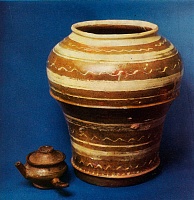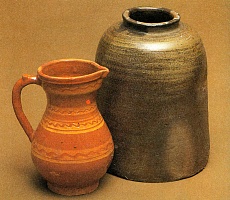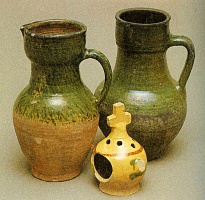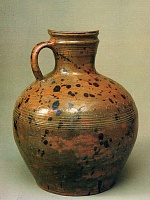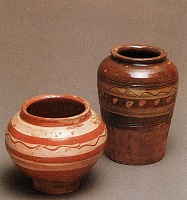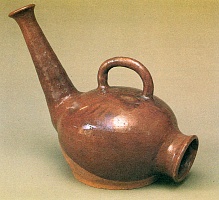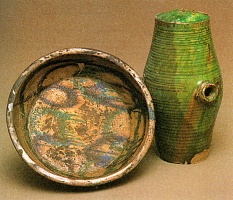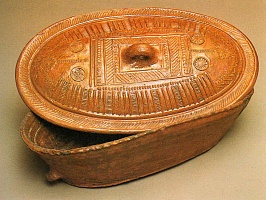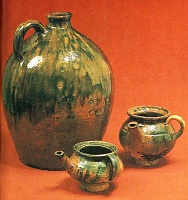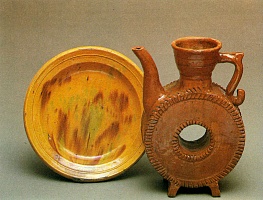Pottery 19-20 th cc.
Special skill was required to make large archaic forms: large vessels for grain, large pots for beer, jugs for home-made drink, ewers, deep dough pots, different pots for cooking, vessels for linseed oil, wash-basins, hollow ware, plates and frying pans.
In different areas they also made various lipped vessels: jugs for beer and kvass, milk buckets, pails, wide and low jelly and melted butter dishes, hanging wash-hands. There were different small vessels: milk jugs, twin pots with lids to carry shchi (cabbage soup) and porridge to the field, pots for cooking cereals, various whistles.
Different areas developed their local characteristics and original techniques, despite the undeniable influence of Moscow - the main ceramic center of the Russian state since the 15th century. Red calcinated vessels with color glazing are remarkable for their perfect shapes. But especially beautiful are black vessels, shimmering with different shades of color. Many centers preserve a high level of red clay pottery. Large vessels clearly reveal the unique beauty of the material. They demonstrate a perfect unity of function and art quality.
The decoration of the 19th century pottery was quite archaic both in technique and in patterns. The basic elements of simple patterns, forming a single- or multi-row ornamental bands were dimples stamped with a pointed stick, pricker, comb teeth or stamp. Free strokes of the stick left on soft wet clay wavy patterns, swirls, oblique incision, dentils.
The laconic graphic ornament of rhythmical lines and dimples suited the impressive shapes perfectly. In the 19th century, simple yet laborious glossing was less frequent. Simple cross, vertical and broken lines were imprinted with a rounded pebble before firing. Dark patterns shone beautifully on the burnt mat surface.
Widespread glazed pottery was in the greatest demand in the 19th century. It was coated with low-melting lead glaze. The most popular yellow color was obtained from iron or lead oxide. Deep brown and violet tints were provided by manganese and the most unusual and varied green tones - by copper oxide.
The iron ochre was commonly used for favorite reddish-brown glazing. Monochrome glaze was applied to unfired ceramic body, which was occasionally primed with a thin layer of engobe (white clay and quartz). Normally, clay vessels were seeped in glazing, poured over with it or glazed with a brush. The ceramic glazes were of great artistic quality. The uneven coloring (dark and thick tones or various light tints) made ceramic articles quite original. The Museum collection mainly includes items decorated with simple monochrome patterns of wavy or broken lines, rings, peas, rosettes, stylized branches.
At the end of the 19th century, the artistic level of folk pottery declined. The competition with manufactured goods changed the line of pottery. There appeared imitations of metal and porcelain shapes untypical of ceramics. They were commercially produced in the village of Bogorodskoye and widely sold all over the Volga River area, up to Astrakhan.
Some utility objects meet the requirements of the inhabitants of the steppe Volga and Caspian sea regions. Cheaper clay articles reproduced Oriental copper vessels. They were milk buckets with lids and long-neck flattened jugs. In the 1920s-1930s, numerous ordinary objects: tea-pots, kettles, mugs, jars, stew pans, deep trays, flasks, kerosene flagons, etc. The simple objects of everyday peasant life, their various shapes and sizes reflect deep traditions of folk art.









